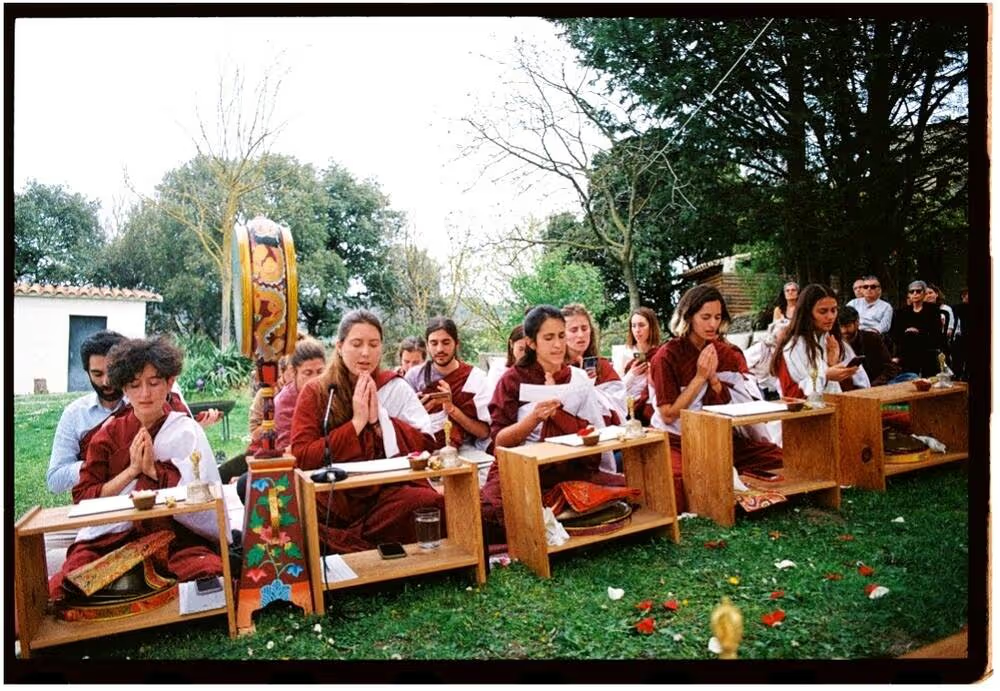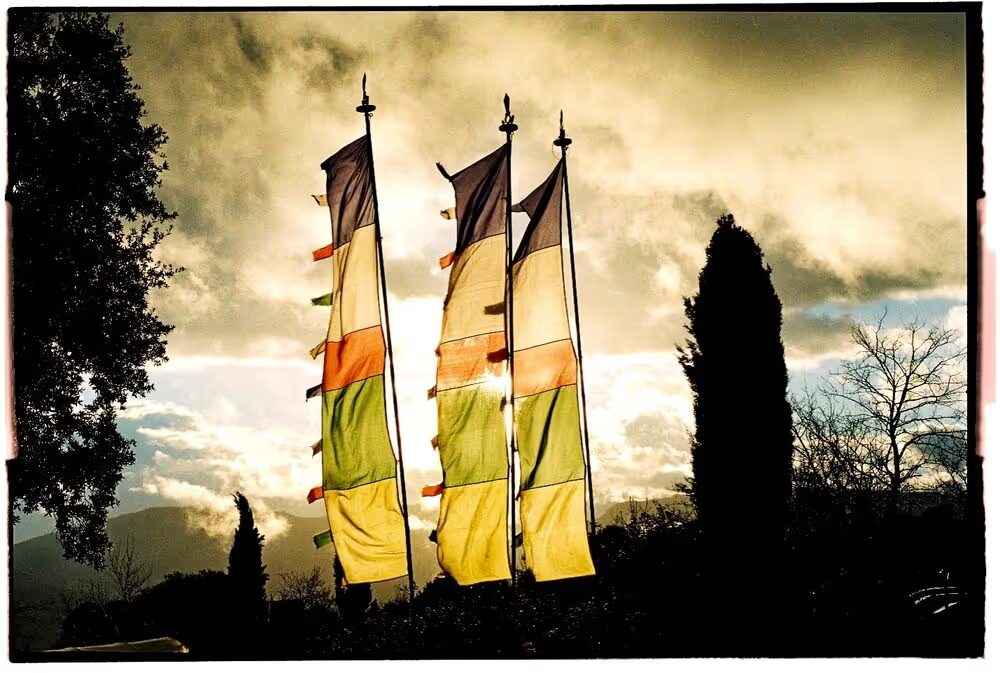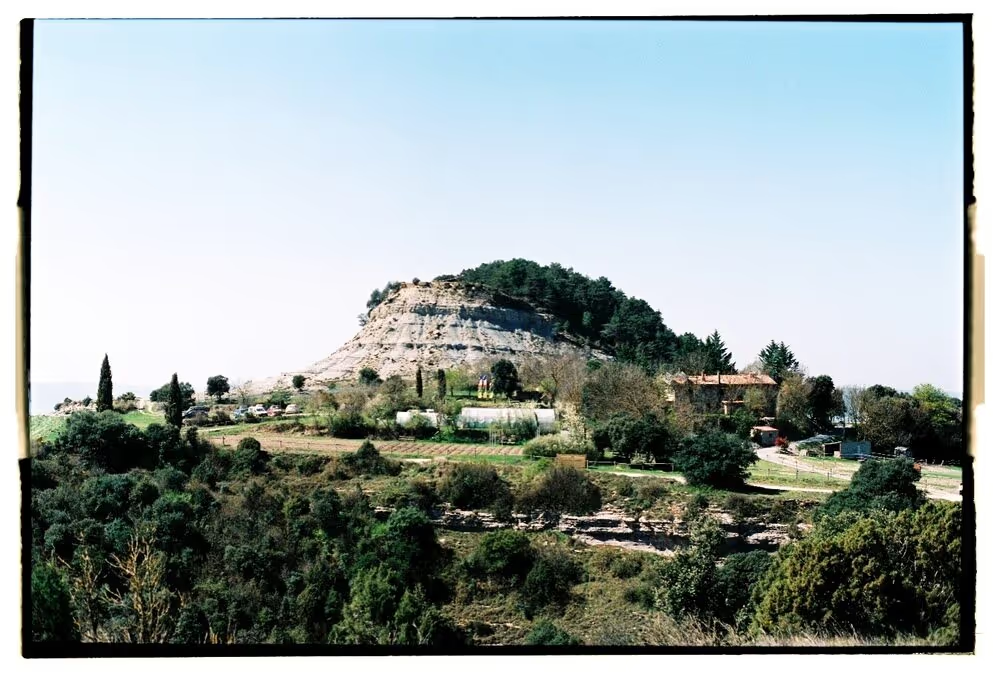Casa Virupa, located in Tavertet, Barcelona, is a prominent meditation and retreat center characterized by its inclusive and non-sectarian approach. Created with the blessing of His Holiness the 41st Sakya Trichen, it is deeply rooted in the Sakya lineage of Tibetan Buddhism, but adopts a Rimé orientation, implying that it integrates diverse Buddhist traditions. Its objective is to provide a space that promotes introspection and well-being, based on values such as compassion and mindfulness.
Since 2020, Lama Norbu has been leading educational activities, enriching the learning experience with the support of national and international teachers. The community, composed mainly of young people from diverse backgrounds, finds in Casa Virupa a space to explore and develop their personal and collective consciousness.

Casa Virupa is consolidated as an inclusive space where people at different stages of their spiritual development can work towards their own well-being and that of others, standing out for its integrative approach and its openness to diverse traditions.
The following is an interview with Gloria Cagigal, co-founder of the Casa Virupa Buddhist community. Gloria is part of the pedagogical team, is a meditation instructor and is responsible for the center's communication area. With a background in philosophy from the University of Barcelona, he has dedicated his career mainly to teaching and communication. In addition, at the residency center for artists and thinkers LAC (Contemplative Arts Laboratory), she plays the role of curator of thought and literature. Gloria is currently pursuing a doctorate, reflecting her ongoing commitment to learning and critical reflection.
BUDDHISTDOOR IN SPANISH: Could you tell me a little about the history of Casa Virupa and its mission?
VIRUPA HOUSE: Casa Virupa was born from the friendship of some teenagers who, at an early age, discovered the Dharma. At the age of 16, who is now Lama Norbu, began to investigate Buddhism and shared it with his friends at the institute. He picked up a career and focused on Dharma ever since, both in studies and in vocation, but of that school group, some of us accompanied him closely so that, finally, together with two good friends from school and university, we ended up founding Casa Virupa at the end of 2015.

All of this is important for different reasons: first of all, because the atmosphere we breathe —and that we want— at Casa Virupa is one of great fraternity and companionship. There, the role of Lama Norbu is key. In addition to ensuring that we apply Buddhist values to our daily lives, it is a priority for him that we cultivate a respectful and gentle climate, in which care is central. In a project that is eminently structured by volunteering, this is essential. So one of the missions of Casa Virupa is to carry out a life of service crossed by the Dharma out of kindness, towards all beings, of course, but also to each other.
And, secondly, one of our motivations was to create a Dharma center that could challenge young people, because it was difficult to find young practitioners in the dharma centers. Obviously, youth is not a determining factor for practicing at Casa Virupa —basically because it's impermanent—, but it's true that some themes, angles, concerns..., resonate more or less depending on the moment of life. So when we founded Casa Virupa, we wanted young women to find the center that we imagined or that we lacked: a more analytical Buddhism, far from folkloric and new-age, and more committed to the social, political and ecological problems of the contemporary world. In other words, a transfeminist, environmentalist, anti-speciesist and anti-fascist Buddhism. And yes, we are aware of how shocking all these “anti” associates of a Buddhist center are in the spiritual world, but one of the missions of Casa Virupa has to do with expressing ourselves in an uncomplicated way in the political sphere. Because we agree with Audre Lorde that the personal — and therefore also the spiritual — is political.
Along these lines, another of Casa Virupa's missions is to spread the Dharma with a contemporary, current and fresh language and forms. We don't think that the new is necessarily better, but we think that Dharma is a precious good and that it should reach every corner of the world. As things work in our society, it would be naive to think that Dharma can live on the fringes of social networks, aesthetics, and the codes of our times. We agree with Dzongsar Khyentse Rinpoche that Buddhism is not very good at marketing and advertising, so if we want many people to connect with the Dharma, we have to transmit it in a skilful, attractive and rooted way, always with common sense.
Finally, another mission is to transmit the Dharma in a rigorous way. Although we are young and understand that we must use new codes, we have a very deep respect for the Dharma of the Buddha as well as for Tibetan Buddhism, so we try to be very clear about the line between what can be adapted from Buddhism to a specific historical and cultural context and what cannot. That's why we don't avoid talking about reincarnation and doing rituals according to the Sakya tradition, for example. We believe that it is dangerous to sweeten or adapt Dharma to Western mentality so that it is comfortable and digestible. The purpose of Dharma has little to do with comfort: getting rid of our neuroses, prejudices and veils is never a comfortable exercise.

BDE: Could you explain to our readers the main characteristics of the Sakya lineage and what sets it apart from other schools of Tibetan Buddhism?
CV: Our heart is Sakyapa but we have a Rimé, “non-sectarian” orientation. By this we mean that some of Lama Norbu's main teachers are Sakya: who gave his blessing to Casa Virupa and later named slat Lama Norbu is S. S. Gongma Trichen Rinpoche and some of the teachers who advise and visit Casa Virupa most frequently are S.S. Sakya Trizin Rinpoche 43 and H.E. Asanga Vajra Rinpoche. In addition, the vast majority of common practices at the center and texts we work with are Sakyapa.
Now, we have invited teachers from many traditions (Jigme Khyentse Rinpoche, Chagdud Khadro, Ven. Dhammadipa, Come. Robina Courtin, Lama Sherab...) and we have a very clear inclination for the Khyentse lineage, with whom we feel very connected, from Kyabje Dilgo Khyentse Rinpoche to Dzongsar Khyentse Rinpoche and Jigme Khyentse Rinpoche —both of whom we have been taught on multiple occasions— and who are the main teachers of Lama Norbu.
But if our heart is Sakyapa, it is because we are inspired by the lineage of teachers who form it, scholars and scholars with spiritual achievements recognized by teachers from other schools. It's incredible that a teacher like S. S. Gongma Trichen Rinpoche is stepping on the ground today and exercising. We are also amazed by the theoretical and practical corpus of the Sakyas. One of the greatest jewels of the Sakya school is the Lamdré, a very complete teaching system that integrates sutra and tantra practices and that comes from Mahasiddha Virupa. Hevajra tantra is also a reference in tradition and highly valued by other schools, as well as the practices and rituals of Vajrakilaya, unique in their depth and complexity.

BDE: What kind of teaching and practices are offered at Casa Virupa (meditation, retreats, courses, etc.)? Do they have a structured study and practice program?
CV: At Casa Virupa we offer proposals for beginners and for more advanced people. To begin with, you can take a weekend retreat to introduce Buddhist meditation, which provides basic tools to practice on a daily basis, but we always advise that, for those who really want to take root in the habit of meditation and maintain a certain adherence, it is better to take the meditation course.
Our meditation course consists of weekly meetings during the school year and lasts approximately three years. We are providing theoretical and practical content on meditation from the Buddhist perspective, from the usefulness of breathing as a tool for emotional regulation, to the four foundations of mindfulness, the four immeasurable thoughts, the four marks of existence...
Lama Norbu also teaches a biweekly Buddhist philosophy course, aimed at people who already have a base in Buddhist philosophy and which is based on the study and commentary of texts. We have worked on texts such as Separating from the Four Attachments, The Triple Vision, Bodhisattvacharyavatara or The Myth of Freedom.
We are also organizing teaching cycles of a weekend, five days or up to two weeks, with Lama Norbu or other teachers whom we invite. They can be on a specific topic “impermanence” or “patience”, but also on texts, especially those that are part of the corpus of Lojong.
BDE: What are Casa Virupa's aspirations and future projects?
CV: We have a lot of things in mind. One of Lama Norbu's main motivations is to act as a bridge between qualified teachers and a large and young audience, so we will continue to promote this type of meeting. In particular, we would very much like to organize an event with Dzongsar Khyentse Rinpoche in the near future. We know that young people connect a lot with him and we have a way of acting as a starting point.
Another aspiration is to expand and publicize a monthly working group that Lama Norbu has with professionals from the health sector: psychiatrists, psychologists, nurses... The truth is that in our sangha there are many people from this professional field and we think it is essential that they have dharmic tools to face the challenges of their work, which is so necessary. Lama Norbu accompanies them in this process of reviewing and applying Dharma to their work and it's been very nice.
We would also like to continue reaching out to a non-Buddhist audience to bring Dharma closer to their lives. One of the skilful methods that have made this possible, and that Lama Norbu devised in 2022, is the creation of the Contemplative Arts Laboratory, a residency project for artists, thinkers and creatives —not necessarily Buddhists, rather the vast majority are not—and a shuttle for cultural events that, by form or background, have values Contemplatives. This has been a very enriching experience, in which we have entered into a very fertile dialogue with artists and thinkers and, at the same time, it is allowing many people to get to know Casa Virupa through this project.
In the medium and long term, we would like to do an outreach and support project about the end of life that, in the long run, would become a hospice.
There are more things we are thinking about, but we would overdo it if we had to talk about all of them. We are very grateful for this speaker, because it is the first time that a Buddhist media has been interested in us since we founded Casa Virupa in 2015. So thank you very much for giving us the opportunity!
Relevant links:
Podcast: GAME-BOYS with the Buddhists of Casa Virupa
Article (in Catalan): Buddhism, the millennial philosophy that is also practical in Catalonia










